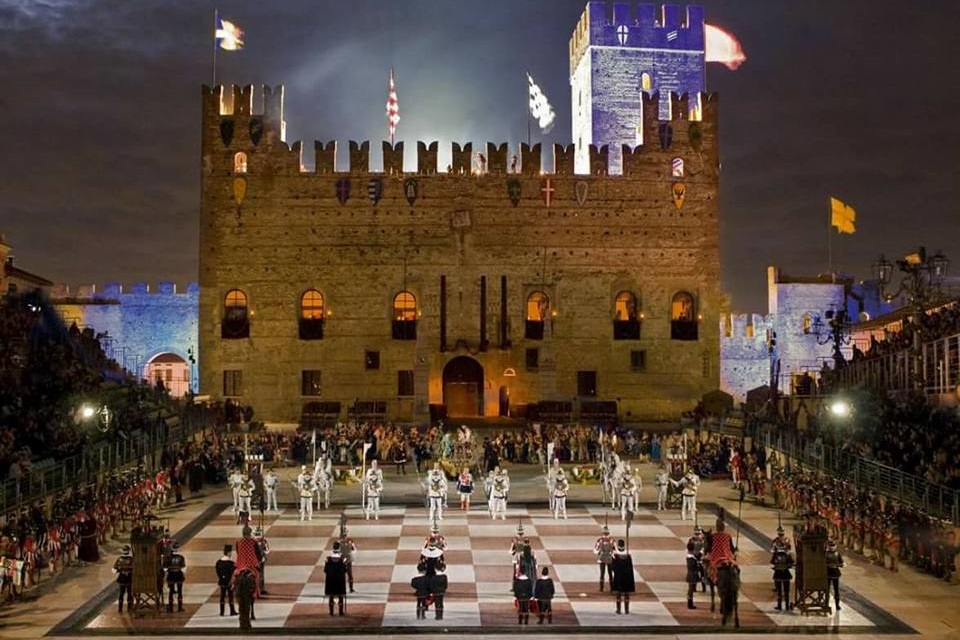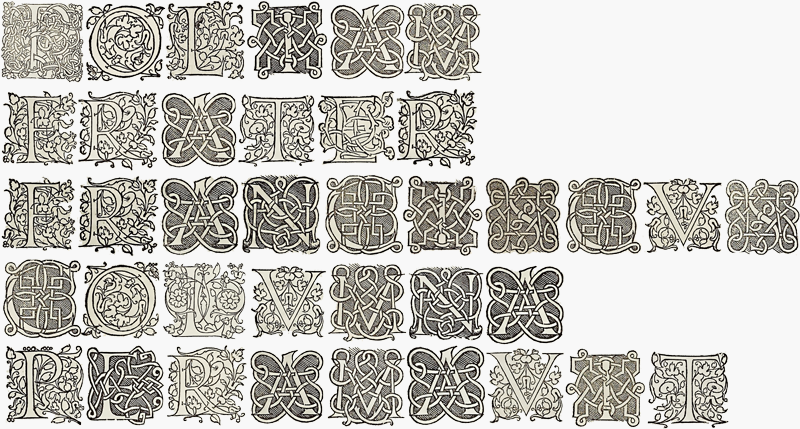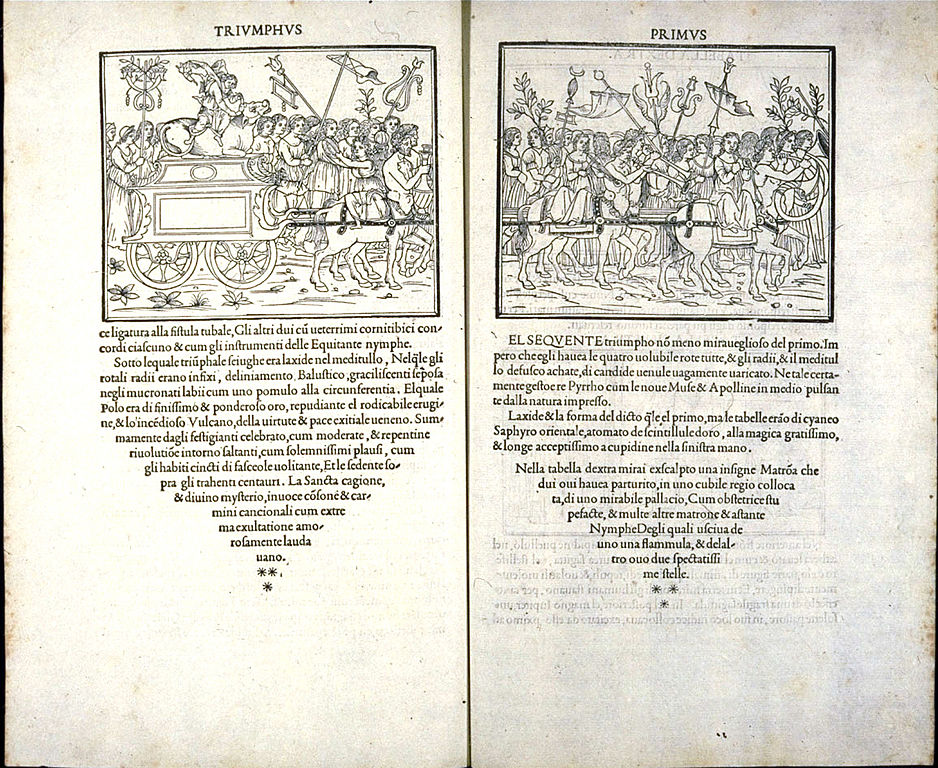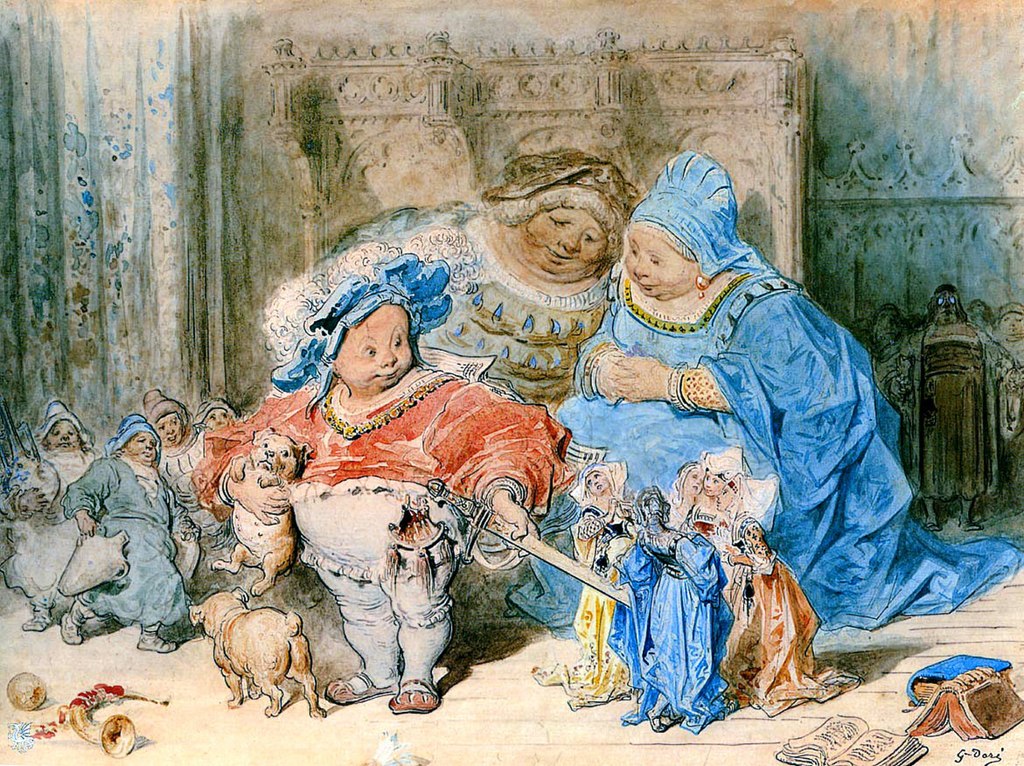


ChessBase 17 - Mega package - Edition 2024
It is the program of choice for anyone who loves the game and wants to know more about it. Start your personal success story with ChessBase and enjoy the game even more.
Hypnerotomachia Poliphili (from the Greek hypnos, 'dream', eros, 'love' and mache, 'fight'), or The Dream of Poliphilus, is a book written in hermetic prose during the Italian Renaissance. In the book, Latin, Greek and Italian are mixed. The work is particularly beautiful from a visual point of view, as it has 172 woodcuts made with mastery.
The text, marked by esotericism and a pronounced eroticism, tells a love story. During the course of the plot, knowledge of different fields comes through — the archaeological, the astronomical, the architectural, the liturgical, the botanical, the gemological and even the culinary.
This work remained relatively hidden until it was republished in Italian in modern times (1959). First, it was assumed that it was written by an anonymous author. However, ultimately the authorship must be attributed to Brother Francesco Colonna. Colonna was a Dominican monk, who served at the monastery of San Giovanni e Paolo in Venice. He was born in 1433 and passed away in 1527. During his career as a clergyman, he preached at St. Mark's Basilica in his hometown.
Colonna's authorship becomes evident after realizing that the decorated initials of each of the thirty-eight chapters of the book create the following acrostic: "POLIAM FRATER FRANCISCUS COLONNA PERAMAVIT", that is, "Franciscus Colonna, who loves Polia desperately".

The acrostic | Image: Vibrisse, bollettino
The twenty-first initial chapters tell the story of Poliphilus. From that point on, the stories are told by Poliphilus' beloved, Polia.
It has been stated that the manuscript was written in 1467, although it originally appeared in Venice in 1499 — at the printing house 'Aldina', owned by Aldus Manucius (1449-1515). The text was reissued several times shortly after its publication. The reissues were made in different geographical points of the peninsula and abroad — one of them came out in France, where, in 1546, it received the name Le Songe de Poliphile.
 Hypnerotomachia Poliphili focuses on the dream of Poliphilus, thus it presents a very suggestive plot treatment, one that has been repeatedly studied in Literature and Comparative Philosophy: the idea that all human things are only part of a dream.
Hypnerotomachia Poliphili focuses on the dream of Poliphilus, thus it presents a very suggestive plot treatment, one that has been repeatedly studied in Literature and Comparative Philosophy: the idea that all human things are only part of a dream.
In fact, psychiatrist Carl Jung (1875-1961) was greatly influenced by this book and used it as a model during the conceptualization of his theory of archetypes and the interpretation of dreams.
The tormented protagonist of the story first falls prey to insomnia — as did the protagonist of The Book of the Duchess, by English author Geoffrey Chaucer (c. 1343-1400) — due to his unrequited love for Polia. But he manages to fall asleep eventually. Within his dreams, he experiences parallel and successive stories, in which he finally concretizes his passion.
At some point, Poliphilus secretly visits Polia, who initially rejected him. In the temple of Diana, the protagonist vanishes and dies at the feet of his object of desire. Then, she drags her body out and hides him, but suddenly Cupid appears and forces her to return and kiss the knight, restoring his life. After this episode, the union is maintained until the end of his days.
In the framework of this work, we pay particular attention to the link between chess and culture, which comes about with the presentation of three choreographies associated with the game. This was the first scenographic image of 'human chess', at least in Western literature.
The relevant passage, here translated by Robert Dallington (1592):
Master Class Vol.9: Paul Morphy
Learn about one of the greatest geniuses in the history of chess! Paul Morphy's career (1837-1884) lasted only a few years and yet he managed to defeat the best chess players of his time.
For which cause, and for the greater setting out of the excesse and abounding excellency, beyond all the rest of her royall magnificence, euery one sitting in their place after the miraculous, wonderful, and sumpteous banket, without any delaie, she commanded a game to be playd by parsonages, not onelie woorthie the beholding, but of eternall remembrance, which was a game at Chesse, in this sort as followeth.
By the entraunce of the curtaine there came in thirty two Nymphes, whereof sixteene were apparrelled in cloth of gold (eyght vniformally without difference of degrees) afterwards one of those sixteene was apparrelled in princely robes lyke a King, and the other lyke a Queene, with two tower-keepers or Rookes, as wee tearme them, two counsell-keepers or Secretaries, wee tearme them Bishoppes, and two Knights. In like sort were eight other in cloth of siluer, vnder the like gouernement and magistracie as aforesaid.
Euerie one of these according to their duties, tooke theyr places vppon the checkers of the pauement, that is, sixteene in golde of one side in two rowes, and sixteene in siluer of the contrarie side.
The Musicke beganne vppon a sodayne with a rare inuention to sound a charge with a pleasaunt concord, participating togeather a sweete and thundering melodie, hauing in it a deuine furie.
At the measured sounde and time of the Musicke vppon their checkers, as it pleased the King to commaund, the pawns turning themselues with a decent reuolution, honouring the King and the Queene, leapt vppon an other checker before them.
The King of the white men, his musicke sounding, commaunded her forward that stoode before the Queene, and the same with lyke reuerent behauiour marched forward her continent, and stoode still. And according to the mensuration of the musicall time in this order, so they chaunged their places, or continued vppon the checkers dauncing, vntill that they were eyther taken or commaunded forward by the King.
If the musicke kepte still one time, those eyght vnyforme pawnes did spende the time in marching forwardes into an other checker, neuer comming backe vntill that worthily without touch or appalement of courage, they had leapt vppon the line of that square where was the residence of the Queene, proceeding straight on, vnlesse she tooke a prisoner by a Diagonick line.
The Bishop went in a Diagonike line, still holding that coloured checker wherein he stood first. The Knight ouer two checkers before him taketh the next of eyther handes, and of a contrary colour to that hee stood in immediately before. The Castle-keepers or Rookes might passe ouer manie checkers streight on as they pleased at commaundement, so that they might goe one, two, three, foure, or fiue checkers, keeping a measure, and not staying in their march. The King might goe vpon anie checker if none were in it, or backeward, and cause any other to remooue for him, and make him roome. The Queene might goe any way, but it is best when shee is neare her husband on euery side.
And whensoeuer the officers of eyther of the Kings shall finde one without guarde of helpe, they take her prisoner, and both kissing one another, she that is ouercome and taken, goeth foorth and standeth by.
Thus they continued playing and dauncing according to the time of the musicke, with greate pleasure, solace, and applause, vntill the King of the siluer Nymphes was victour and conquerour.
This solemne sport, what with resistance flying backe, and seconding of one an other, with such a measured circulation, reuerence, pause, and modest continencie, endured the space of an hower, whereat I tooke such pleasure and delyght, that I imagyne (and not amysse) that I was rapt vpon the sodaine from the liking of the sportes of Olympus to a newe felicitie.
This first game beeing ended, and conquest obtayned, all retourned into theyr accustomed places, and in like manner as at the first, so the second time euerie one in theyr appoynted checkers, the Musicke chaunging theyr measure, so the moouings and gestures of the players were altered. And obseruing the time of the musicke in a conuenient order, and approoued gesture and arte, that it was no neede to commaund or say any thing.
But the cunning and experte Nymphes, with theyr plentifull tresses effused ouer theyr delicate shoulders hung wauing, and in theyr motion forwardes would streame out at length, 65S somewhat shewing their backes, about their heades wearing Garlandes and Crownes of Violets. And when any one was taken, they lifted vp their armes and clapt handes. Thus playing and coursing vp and downe, the first continued still conquerour.
In the last game and daunsing, they beeing all returned to their distributed places, the Musicke againe sounded a measure phrygiall in as perfect and prouoking furie as euer Marcias of Phrygia inuented.
The King in robes of Golde, caused the yoong Damosell that stood before the Queene, to marche forwarde to the third Checker, direct in the first remooue, whereupon immediately there was seene a battaile and Torney, with so swift and sodaine forces, bending themselues to the grounde as it were lying close vpon their Garde, and presently vpon it capering vp with a turne twise aboue ground, one iust opposite against an other, and vpon their downe come withall a turne vpon the toe thrise about.
All this Action they did at one time, with such a grace and agilitie, as nothing could be better, with their lowe inclinatitions, high Capers and Turnings, without affectation of strayning, as it should seeme with facilitie and careles ease at pleasure and sweete iestures, as in such a thing may bee imagined, and not else where to bee seene. Neuer any one troubling an other, but who so was taken prisoner, did presently kisse their Conquerour, and voyded the place. And the lesser number that there was, the more pleasure it was to perceiue the pollicies of either sides to ouercome other.
And such an order and motion was vsed of euerie one, in a commendable sort without fault, as the measure and time of the Musike appointed, stirryng euen them that looked on to haue a motion in their sinowes and mindes to doo the lyke, there was such a concord and agreement betwixt nature and the Musike especially, seeing the performance of the same in the actions of others.
Vpon this occasion I was moued to call to remembrance the force of Timotheus, the most cunning musitian, who with his voice and measure vppon his Instrument would prouoke the great Macedonian Alexander, violently to take Armes, and presently altering his voyce and tune, to forget the same, and sit downe contentedly. In this third game, they apparrelled in gold did triumph in the victoritie.

From the point of view of chess, we can highlight the following elements in the passage:
Master Class Vol.4: José Raúl Capablanca
He was a child prodigy and he is surrounded by legends. In his best times he was considered to be unbeatable and by many he was reckoned to be the greatest chess talent of all time: Jose Raul Capablanca, born 1888 in Havana.
1. Chess is not mentioned specifically, although it is clear that the excerpt is referring to the game, which was widely popular at the time.
2. The protagonists are located on each side of a gridded surface, on a board of giant dimensions.
3. A situation which involves both play and dance is mentioned, so it is clear that we are in the presence of a scenographic representation of the game.
4. The number of participants is exactly 32, with 16 pieces allocated to each player. The pieces are represented by young girls, ones dressed in gold and the others in silver (which means that the colours do not respond to the black and white taxonomy that would later become conventional).
5. From each set, 8 participants were dressed uniformly — these clearly correspond to the image of the pawns, which could not retreat, although curiously they are allowed to advance diagonally (and there is no mention of this happening only when a capture took place).
6. Of those who were dressed diversely, one was wearing a royal mantle (the king in the game); another, the dress of a queen (the queen, now considered as a piece and not merely by her attire).
7. Of the remaining differentiated pieces, two were captains or custodians of the fortress, two were taciturn persons or secretaries, and two were knights: the images of the rook, the bishop and the knight.
8. The captains or custodians of the fortress (Custodi della Rocha, in the original), can advance many squares in a straight line and freely, that is, at a time they could move three, four or five squares. It is, of course, the figure of the rook, so we can assume it could also advance a maximum of eight squares, including the one it was currently occupying. Note that in Latin the piece is called Rochus, as Marcus Hieronymus Vida (1490-1566) named it in his poem of 1513, Scacchia Ludus.
9. The taciturn persons or secretaries (Taciturnuli or Secretarii, in the original), move diagonally, and they do it up to a length of three squares, which implies the original movement of the bishop (previously known as elephant) —it jumped over the intermediate square. The name alludes to a reserved nature, perhaps referring to the fact that this piece was supposed to be the monarch's confidant, a task that demands extreme discretion.
10. The knights (Equiti, in the original) also moved through a maximum of three squares, but in this case they advanced two squares in a straight line and one in transverse direction; they could do it to any side.
11. The king (Re, in the original) could be placed on any square except those occupied or undefended, as it was forbidden for him to go to a square to which another piece could jump. If he did, he should be warned, which clearly refers to the concept of "check".
12. The queen (Regina, in the original) could move around to any square of the colour which she first occupied, and it is suggested to her that "the best thing is to always stay by her husband's side". Although it is not fully clarified, this recommendation implies that its movement was limited — most likely, this was inherited from the Eastern tradition, which had the vizier, a piece that could only move one square diagonally. Nonetheless, the existence of such piece is rather relevant.
13. It is clear that the game was played using the parameters of the ancient chess modality, which came from the Eastern world and had not evolved definitively in Europe. The modality later baptized in the Italian peninsula as chess "alla rabiosa" was not yet in force.
14. The Spanish and Italian specialized texts which introduce chess in its modernized version — such as Luca Pacioli's De Ludo Scacchorum (1447-1517), which contains beautiful images attributed to Leonardo da Vinci (1452 -1519) — appeared at the end of the century, while this book appeared in 1467. It is understandable, therefore, that the medieval model was the one described. This is also a revealing fact: the transition between systems took place precisely in the course of the fifteenth century.

Polia kisses Poliphilus back to life
Chess was prominent in the Muslim culture, which we now know was the main source from which the game would later be introduced in Europe. Within the boundaries of the Muslim faith, the use of imagery that referenced people or animals was frowned upon, which led to the use of abstract designs.
Therefore, it is rather strange that in Granada, Spain, at the beginning of the 15th century, the sultans — who still dominated the territory — allowed the presentation of 'human chess' exhibitions. Had these events occurred, their own intimate religious convictions would have been contradicted.
In a not-at-all-festive circumstance, at the end of the same century, in the Iberian Peninsula, prisoners were exhibited in what were called 'inquisitorial representations', on chequered boards of real size. The detainees represented pieces of an ominous chess game.
It has been assured by multiple sources — for example, in the extensive chronology of English historian Bill Wall — that the first time these 'human chess' events took place was during the reign of Charles Martel (686-741) in France, precisely in 735. It is believed that the founder of the Carolingian dynasty played his games using people of flesh and blood, who had to replay the movements on a human-scale board.
However, there is sufficient evidence to consider this story more as a legend than as part of reality. In fact, chess entered the Gallic territory much later. At the most, Martel might have played some other kind of game, not exactly chess.
It is more likely that 'human chess' was born much later — at least in terms of its link to European culture — in Marostica, an Italian city that over time has been offering such representations as a tourist attraction . Currently, they are organized every two years, with the next edition scheduled for September 2020.
Sagar Shah shows you on this DVD how you can use typical patterns used by the Master of the past in your own games. From opening play to middlegame themes.
The first time this kind of meeting took place was on September 12, 1454, when a 'human chess' match was played following the script of another love story, much like Poliphilus'. In this case, two noblemen, Rinaldo d'Angarano and Vieri da Vallonara, fell in love with the beautiful Lionora, daughter of Taddeo Parisio, lord of the Marostica Castle. The suitors, who were supposed to have a duel, were forced to change their original plan and settle their dispute in a peaceful game of chess.
Geographical proximity (the distance between Marostica and Venice is less than 100 km) and temporary proximity (the episode that led to a 'human chess' match in that city and Colonna's book correspond to the same century) indicate that the author of Hypnerotomachia Poliphli might have known the real story, which could have easily given birth to the fictional tale. Perhaps the author decided to immortalize the anecdote in his work.
Colonna's work was clearly influential in later times, particularly when a similar story was used in Gargantua and Pantagruel, the classical text written by French author François Rabelais (1494-1553). In chapter XXV of the fifth book of the series — attributed to Rabelais, although its authorship has been questioned (in fact, it was published after his death) — a ballet choreography is presented, made up of 32 figures, half of them dressed in gold and the other half in silver, who represent three matches, analogous to the dances in Hypnerotomachia Poliphli.

Gustave Doré, L'enfance de Gargantua
The author names the pawns nymphs; the bishops, archers; the rooks, guardians; adds the classical knights; and locates the queen to the left of the king, which is common nowadays, although at that time it was not always the case.
The queen sometimes advances two squares, a timid demonstration of empowerment. Promoting a pawn to a queen is also permitted — since the pawns were called nymphs, the old ethical issues related to transsexualization are thus circumvented.
We can conclude that Francesco Colonna, with Hypnerotomachia Poliphli, offered a suggestive iconography. For the first time in history, 'human chess' games are depicted in Literature, with the pieces following a musical rhythm while performing beautiful choreographies.
The author demonstrates the popularity and cultural prestige that the game acquired in Europe during the Middle Ages. This is why it was included and celebrated in an enigmatic yet influential book — a book that, in addition, was a pioneer which transcended the boundaries of time and space.
The ability to transcend the boundaries of time and space is, as we very well know, a quality that, from its origins, rigorously and successfully, has been a feature of the ancient yet undying royal game.
Translation from Spanish: Carlos Colodro